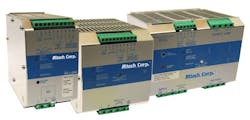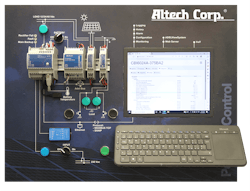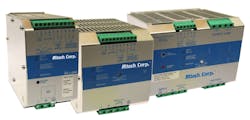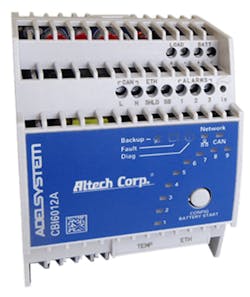Direct Current Uninterruptible Power Supplies for Industrial Applications
Edited by Sharon Spielman
Direct current uninterruptible power supply (DC UPS) systems act as a cornerstone in safeguarding critical operations and sustaining productivity by providing uninterrupted power supply during unforeseen power disruptions.
Here, we explore the essential features and functions of DC UPS systems; their diverse topologies; the role of battery technology in enhancing runtime and reliability; the significance of monitoring and management software for optimized performance; and the considerations regarding size capacity and scalability.
Features and Functions of DC UPSs
A DC UPS serves a similar purpose to its alternating current (AC) counterpart but operates with AC or DC power sources and is tailored for applications where DC power is used. Essential features and functions of a DC UPS in safeguarding electronic equipment during power fluctuations and outages include battery backup for the whole system; voltage regulation for the load; surge protection for the system; monitoring and alarms functions; automatic or controlled shutdown capability; higher efficiency than AC back-up systems; remote monitoring and management ability; easy customization for specific applications; and simple maintenance and serviceability. Overall, a DC UPS is a critical component for ensuring continuous operation and protecting against power disruptions in DC-powered applications.
DC UPS Topology Affects Performance, Suitability for Different Load Types
The topology of a DC UPS refers to the specific design and configuration of its components, including how power is processed and delivered to connected loads. Different topologies—including line interactive, double conversion (online UPS), Delta conversion, ferroresonant, and pulse width modulation (PWM) or switch mode—influence UPS performance in different ways
Line interactive UPS systems typically regulate voltage using an automatic voltage regulator (AVR). They switch to battery power during outages or severe voltage fluctuations and offer basic protection against power disturbances and are suitable for moderate loads. Commonly used for industrial machines and equipment where moderate power protection and voltage regulation are sufficient, they can handle motor-driven loads and other equipment that requires stable voltage but may tolerate brief interruptions during switchover to battery power.
Online UPS systems continuously convert AC power to DC and then back to AC, providing the cleanest and most reliable power output. They offer zero transfer time to battery mode, ensuring seamless operation without interruptions. These are ideal for critical machine design applications where even the smallest power interruption can cause significant disruption or damage. They provide high-quality power suitable for sensitive electronic loads, precision instruments, medical equipment and CNC machines. The constant conversion ensures consistent voltage and frequency, making them versatile for a wide range of loads.
Delta conversion UPS systems are a variation of the double conversion topology, designed to improve efficiency and reduce operating costs compared to traditional online UPSs. They feature faster response times and less energy loss during operation. These are suitable for applications where high efficiency and lower operating costs are priorities, while still maintaining excellent power quality. They can handle various machine design loads, including industrial automation systems, robotics and other equipment requiring reliable and efficient power protection.
Ferroresonant UPS systems use a ferroresonant transformer to regulate voltage, providing a constant output even when input voltage fluctuates. They offer robust protection against voltage sags and surges. These systems are suitable for rugged industrial environments where equipment is exposed to frequent voltage fluctuations and harsh conditions. They are often used in manufacturing plants, telecommunications and heavy machinery applications where consistent voltage regulation is critical for reliable operation.
PWM UPS systems use pulse width modulation techniques to regulate voltage and provide battery backup during outages. They are efficient and compact, suitable for smaller-scale applications or where space and cost are constraints. They can protect sensitive electronic loads such as control panels, small motors and programmable logic controllers (PLCs) effectively.
Machine design applications require careful consideration of UPS topology to ensure compatibility with the equipment’s power requirements and operational needs. Choosing the right UPS topology involves evaluating factors such as load sensitivity, tolerance to power interruptions, efficiency goals and environmental conditions where the equipment operates.
Battery Technology’s Influence on Runtime, Reliability of a DC UPS
When it comes to determining the runtime and reliability of a DC UPS, battery technology influences aspects such as runtime, reliability, performance under load and safety and environmental considerations.
Regarding runtime, factors such as capacity, battery type and configuration must be considered. The capacity of the batteries, measured in ampere-hours (Ah) or watt-hours (Wh), directly determines how long the UPS can provide backup power. Higher capacity batteries can sustain the load for a longer duration before needing recharging.
Different battery chemistries, such as lead-acid, lithium-ion or nickel-cadmium, have varying energy densities and discharge characteristics. Lithium-ion batteries generally offer higher energy density and lighter weight compared to traditional lead-acid batteries, potentially providing longer runtime for a given size and weight.
The number and configuration of batteries in the UPS affect the total capacity and thus the runtime. UPS systems can be configured with multiple battery strings or modules to increase overall capacity and extend runtime as needed.
Regarding reliability, it is necessary to consider cycle life, temperature sensitivity and maintenance requirements. Battery technology impacts how many charge-discharge cycles a battery can endure before its capacity significantly degrades. Lithium-ion batteries typically have longer cycle life compared to lead-acid batteries, which may require periodic maintenance and replacement.
Some battery chemistries are more sensitive to temperature variations. Ensuring the UPS environment is within recommended temperature ranges for the batteries helps maintain reliability and longevity.
Battery technology influences maintenance needs. Lead-acid batteries often require periodic checks for electrolyte levels and terminal corrosion, while lithium-ion batteries generally require less maintenance but may need firmware updates or occasional monitoring for optimal performance.
Discharge rate and efficiency affect the performance under load. Different battery chemistries have varying discharge characteristics. Some batteries can discharge at higher rates without significant voltage drops or heat generation, which is crucial for UPS systems powering equipment with sudden high-power demands. Battery technology affects how efficiently the UPS converts stored energy into usable electrical power. Modern battery technologies like lithium-ion generally offer higher efficiency compared to older battery types, minimizing energy loss during charging and discharging cycles.
When it comes to safety features, advanced battery technologies often include built-in safety features such as thermal management systems, overcharge protection and internal cell monitoring to prevent hazardous conditions like thermal runaway.
Additionally, battery technology choice can impact environmental considerations such as recyclability, disposal requirements and energy efficiency during production and operation.
Importance of Monitoring and Management Software
Monitoring and management software are important for optimizing the operation and efficiency of a DC UPS. For example, monitoring software provides real-time visibility into the status and performance of the UPS system. It allows operators to monitor parameters such as battery voltage, current load, temperature and runtime remaining. This real-time data helps in proactive maintenance and troubleshooting, ensuring the UPS operates within optimal parameters.
Additionally, the software can generate alerts and notifications for critical events such as power outages, battery faults or system failures. These alerts enable prompt response and intervention, reducing downtime and minimizing the risk of damage to connected equipment.
Many UPS monitoring software solutions offer remote management capabilities, which allows administrators to monitor and manage UPS systems from a central location or via a web-based interface. Remote management facilitates quick diagnosis of issues, remote configuration changes and firmware updates without needing physical access to the UPS unit.
Also, monitoring software typically logs historical data related to UPS performance and power events. This data can be analyzed to identify trends, predict maintenance needs and optimize UPS settings for improved efficiency and reliability over time. It helps in making informed decisions regarding UPS capacity planning and load management.
The software also allows administrators to monitor the load on the UPS and ensure it operates within its capacity limits. This helps in distributing loads evenly across multiple UPS units if necessary, optimizing overall efficiency and extending battery life.
Advanced monitoring software provides insights into battery health, including state of charge, temperature and expected lifespan. This information helps in proactive battery maintenance, such as scheduling replacements before batteries reach the end of their useful life, thus minimizing the risk of unexpected failures.
This software can also contribute to energy efficiency by providing data on energy consumption patterns and efficiency metrics. This information allows operators to identify opportunities for energy savings, optimize UPS configurations and implement energy management strategies to reduce operating costs.
Many industries have regulatory requirements or standards regarding power management and uptime. Monitoring software helps in generating reports and documenting UPS performance metrics for compliance purposes, audits, or internal reporting.
Specifying a DC UPC for an Industrial Application
Factors such as size, capacity and scalability are important considerations when selecting a DC UPS for specific industrial applications.
The physical size of the DC UPS unit is important, especially in industrial environments where space may be limited or where the UPS needs to be integrated into existing equipment or control panels. Mounting options also need to be considered, including whether the UPS can be rack-mounted, wall-mounted or placed in a cabinet. The size and form factor should align with the available space and installation requirements of the application.
The capacity of the DC UPS should match or exceed the power requirements of the equipment it is intended to protect. This includes considering both the continuous power demand (in watts or kilowatts) and the peak power demand during startup or operation.
Battery capacity determines the runtime of the UPS during a power outage. Larger battery capacities provide longer backup times, which is critical for applications where extended downtime can lead to significant production losses or safety risks.
Industrial applications may require scalability to accommodate future growth or changes in power requirements. A DC UPS that supports modular expansion of battery capacity or power output allows for scalability without needing to replace the entire UPS unit.
Scalability can also refer to redundancy options, where multiple UPS units can be paralleled or configured in a redundant setup to ensure continuous operation even if one unit fails.
Let’s take a look at how DC UPS can be used in specific industrial applications, including process control, telecommunications, medical equipment and data centers.
- For applications such as process control systems or manufacturing automation, reliability and uptime are critical. UPS systems with high reliability, redundancy options and remote monitoring capabilities are typically preferred.
- Telecommunication equipment requires UPS systems that can handle varying loads and provide seamless power transfer to battery backup during outages.
- UPS systems for medical equipment must meet stringent reliability and safety standards, with features such as medical-grade isolation and compliance with healthcare regulations.
- Data center UPS systems require high efficiency, scalability to support increasing IT loads, and advanced monitoring capabilities for optimizing energy usage and maintaining uptime.
It is also important to know the operating environment and protection levels required. Considerations include temperature extremes, humidity levels and exposure to dust or contaminants. The UPS should be rated for the environmental conditions of the industrial setting to ensure reliable operation. And some industrial environments may require UPS systems with higher levels of ingress protection (IP rating) to withstand harsh conditions or potential exposure to water or chemicals.
Selecting a DC UPS for specific industrial applications involves evaluating size, capacity and scalability alongside the specific operational and environmental requirements of the application. A well-chosen UPS system ensures reliable power protection, minimizes downtime and supports the continuity of critical operations in industrial settings.
About the Author

Laszlo Gyorgypal
Product and Quality Control Manager, Altech Corp.
Laszlo Gyorgypal is a product and quality control manager at Altech Corp.





